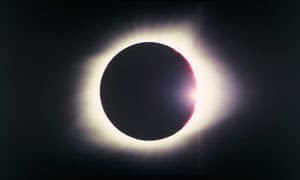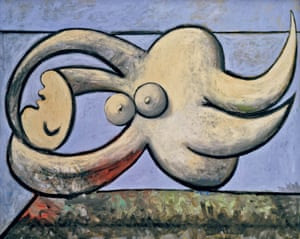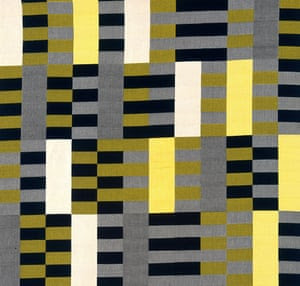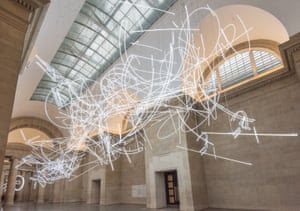A Tacita Dean triple whammy, Picasso’s banner year, a shabby swimming pool and Glasgow queered up by Tai Shani

Great complexity … Tacita Dean’s Antigone (2018), which she premiered at the Royal Academy. Photograph: Courtesy the artist/Frith Street gallery, London/Marian Goodman gallery
1. Tacita Dean: Portrait, Still Life, Landscape
National Gallery, National Portrait Gallery, Royal Academy, London
It could have been too much, an act of artistic hubris, for Tacita Dean to have three interrelated exhibitions this year. At the NPG, she made a new film portrait in which actors David Warner, Ben Whishaw and Stephen Dillaneappear to react to one another, while never in fact being in the same room or the same country. Dean’s portrait films dwell on the subjects in the way paintings might. David Hockney smokes, Mario Merz sits in his garden, poet Michael Hamburger examines his apples, choreographer Merce Cunninghamsits absolutely still in his dance studio. Nothing happens, except time, being, presence.
Sign up to the Art Weekly email
Read more
At the National Gallery, Dean explored the idea of still life, through her own films and works from the museum’s collection and elsewhere. At the RA, she premiered Antigone, a double-screen 35mm film of great complexity. (Dillane is there again, with poet and classics scholar Anne Carson.) With its multiple layers and viewpoints, locations as far apart as Yellowstone, the Mississippi floodplains and Bodmin Moor, and Dean’s innovative technical manipulations – the entire film is edited in the camera – Antigone weaves together more than just the visible world. The conundrums of names, a solar eclipse, copulating dogs and Antigone and Sophocles all become part of the tapestry. If there is a narrative, it is life itself, and making sense of the things around us. This is Dean’s most ambitious work yet. My (triple) show of the year.
2. Anni Albers
Tate Modern, London
Anni Albers made textiles not as a substitute for painting but on their own terms. Taking us from the Bauhaus to Black Mountain College and Connecticut, this revelatory and beautifully installed exhibition shows just how innovative Albers was as a textile designer and weaver. Even at its most geometric, her work feels human and alive – less the product of the mechanics of the loom, the construction of a matrix of threads and fibres, warp and weft, than of the hand and the mind.
Anni Albers’ Study for an Unexecuted Wallhanging (1926). Photograph: © 2018 The Josef and Anni Albers Foundation / Artists Rights Society (ARS), New York/DACS, London
3. Danh Vo: Take My Breath Away
SMK Copenhagen
Martyred missionaries, personal and family history, body fragments and mementos – Danish/Vietnamese artist Danh Vo’s sculptures, installations and much besides infiltrated the National Museum of Denmark. Including letters from Henry Kissinger about his love of musicals and ballet, ceramic bowls decorated with the hideous violence of the conquistadores in New Spain, sections of a lifesize replica of the Statue of Liberty and a chandelier that had hung in the room where the Paris peace accord ended the Vietnam war were all brought together in a terrific exhibition.
4. Manifesta 12
Palermo, Sicily
The European travelling biannual fetched up in Palermo, delving into the city’s history, its infrastructure position as a crossroads of migration at the edge of Europe. Highlights included Spanish artist Cristina Lucas’s vivid digital documentation of bombings of civilian targets, from 1911 to the present day, in a work of numbing, accumulated injustice. Meanwhile, Sicilian group Masbedo installed a projection of a puppet among the centuries of documents, denunciations, trials and secrets piled high in the state archives. This was the single best work I saw all year, a perfect combination of setting and intervention.
5. Picasso 1932: Love, Fame, Tragedy
Tate Modern, London
Travelling from Paris to Tate Modern, Picasso 1932 told the story of a year through paintings and sculpture, letters, photographs and a host of archive material. But it was Picasso’s paintings, and in particular those that depict his sleeping lover, Marie-Thérèse Walter, whom he first met in the street in Paris in 1927 when she was just 17, that stand out. Picasso’s art became as fraught as his life in 1932, and his work was by turns tender, monstrous, magnificent and creepy, an ego in convulsion.

Monstrous, magnificent and creepy … Picasso’s Reclining Nude (1932). Photograph: Succession Picasso/DACS
6. Strange Days: Memories of the Future
The Store X/Vinyl Factory, London
A terrific show of video, film and digital art that demanded repeated visits, Strange Days had 21 artists spread over three floors, curated by the New Museum in New York’s artistic director, Massimiliano Gioni. Lili Reynaud-Dewar dances, Amazonian fishermen caress their catch and Wong Ping provides a hilarious, brutal animation. Kahlil Joseph’s 20-minute loving homage to the Harlem music scene, Fly Paper, was the star work, ending with a quote from Chris Marker’s film Sans Soleil. “If they don’t see happiness in the picture, at least they’ll see the black.”
7. Tomma Abts
Serpentine Sackler Gallery, London
Twenty-five small paintings hung at a measured pace around the Serpentine Sackler gallery. Each a journey, begun with no clear idea of a resolution. No wonder I kept going back and forth, to and fro, walking with Tomma Abts. Her abstractions (rarely is the word so apt) made me feel abstracted, too – baffled and delighted. Games for the eye and trapdoors for the mind, their surfaces shuffle and sheer with perspectival anomalies, interrupted patterns, fault lines and shadowy recesses. Mesmerising.
8. Cerith Wyn Evans
Hepworth sculpture prize, Wakefield
Cerith Wyn Evans won the second Hepworth sculpture prize with a complex glass piece that hung alone in a small gallery. With its 27 blown glass flutes, translucent armatures and piping, the sculpture appears as an insubstantial filigree drawing. It is also a musical instrument. The two main elements play to one another, in an always shifting algorithmic call and response, emitting a low and haunting music. The work makes you intensely aware of space and time, of volume, acoustics and the ways we displace the air as we move. What a wonderful thing it is.
Wonderful … Cerith Wyn Evans’s Forms in Space ... by Light (in Time). Photograph: Cerith Wyn Evans/Joe Humphreys/Tate Photography
9. Elmgreen & Dragset: This Is How We Bite Our Tongue
Whitechapel Gallery, London
The Scandinavian duo turned the ground floor of the Whitechapel gallery into an ill-loved public swimming pool, replete with patrolling guards and the smell of chlorine. It left visitors teetering on the brink, unsure if they’d come to the right place, or where to hire a towel. The highpoint of their show, the empty pool might have been about the decline of public amenities, but it was also a kind of trompe l’oeil, a marvellously unhinged double-take.
10. Tai Shani
Glasgow International festival
Tai Shani’s Tramway installation Dark Continent: Semiramis was the best and most frustrating thing the last GI festival had to offer. Part-installation, part-stage set, the work was as much tableau vivant as theatre. There were knickers, there was dirty talk, there was declaiming, and it was in 12 parts. Dangly things and geometric shapes and an object like a giant pink colon, or the snake in the garden, filled the stage. It was most peculiar, utterly memorable, and very queer.



